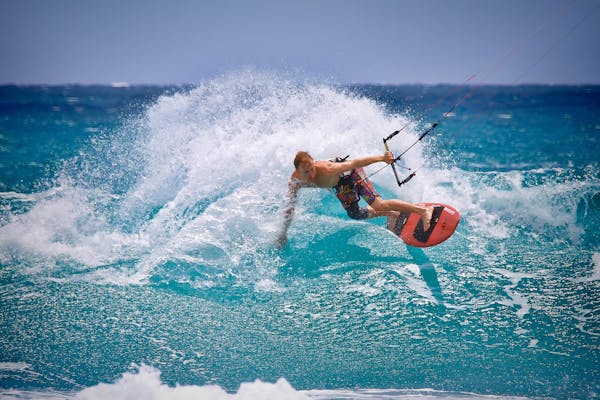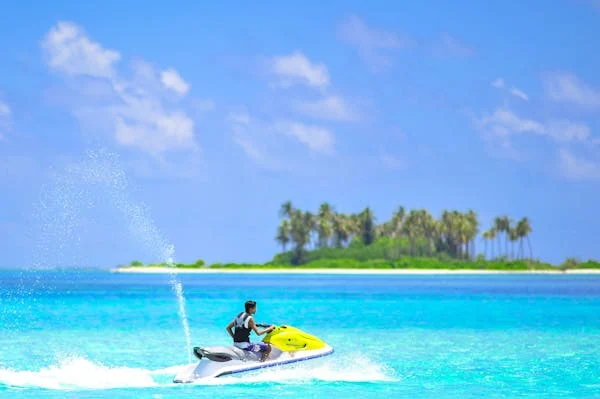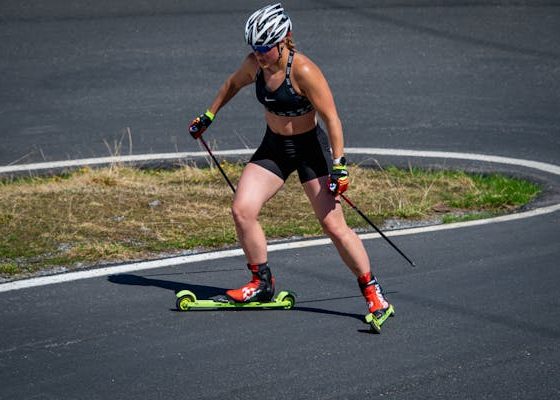If you’re tired of the same old gym routine, it’s time to hit the water! Getting fit in the pool or at the beach can mean a whole lot more than just swimming laps. Check out these five top water sports, a peek at their calorie-busting and body-toning benefits, and how to get started. This post will highlight the most popular and the best water sports to help you discover your favorite.
Water Sports
Water sports involve physical activities performed in pools, lakes, rivers, and the sea. Widely practiced worldwide, these sports vary in intensity, with some considered more extreme than others. Nonetheless, they all offer enjoyment and contribute to the participant’s fitness.
Water sports are inherently enjoyable, offering the excitement of the deep blue waters, the refreshing breeze in your hair, and the adrenaline rush of the activity. While some may be considered risky or extreme, others are calming and invigorating. Regardless of the nature of the sport, whether pursued for leisure or competition, water sports hold universal appeal.
What are the categories of water sports?
Water sports can be categorized as follows:
In-water: This includes swimming, diving, and synchronized swimming.
On-water: This category encompasses rowing, canoeing, water skiing, sailing, and surfing.
Underwater: Diving and underwater photography fall into this classification.
What are the Three Main Types Of Water Sports?
Water sports are categorized into three main types: individual, team, and recreational.
Individual Sports
Individual Sports, also called Solo Sports, are activities where an individual competes alone. These sports need more teammates, requiring participants to rely solely on themselves to accomplish the primary objective. Athletes in individual sports have the freedom to proceed at their own pace, unaffected by the progress of other competitors.
Solo water sports showcase the finest qualities of each contender. While these sports demand diverse skills, they require strength, endurance, determination, and a genuine drive for success and excellence. Individual water sports include swimming, surfing, water skiing, jet skiing, wakeboarding, skimboarding, bodyboarding, paddleboarding, cliff diving, kite surfing, windsurfing, and triathlon.
Team Sports
A team sport involves organizing individuals into opposing teams that compete or cooperate to entertain spectators and achieve victory. Team members collaborate toward a common goal, often by outscoring the opposing team. They establish goals, communicate, make decisions, manage conflicts, and solve problems within a supportive and trusting environment to accomplish their objectives.
Group water sports offer a unique and enjoyable experience compared to individual endeavors. These activities thrive on teamwork, coordination, vitality, synchronized movements, and collective determination to achieve victory. Team Water Sports include synchronized swimming, diving, water polo, rafting, Kayaking, Canoeing, Sailing, Powerboating, Yachting, and Dragon Boat Racing.
Recreational Sports
Recreational sports encompass physical activities primarily promoting fitness, counteracting physical inactivity, and providing enjoyment. They may share similarities with competitive and training-intensive sports but are distinguished by their emphasis on leisure and non-competitive participation.
Recreational sports encompass two aspects: they represent activities individuals engage in during their leisure time. They include movements, games, and sports prioritizing qualitative experiences over traditional performance-driven and competitive elements.
Key characteristics of recreational sports include fostering fun, joy, communication, creativity, self-determination, self-organization, and enhancing body experiences. These aspects contribute to a fulfilling and enjoyable recreational sports experience.
For those seeking relaxation and enjoyment in the water, recreational water sports offer the perfect opportunity to unwind, rejuvenate, and alleviate stress. Travelers often indulge in these activities while exploring aquatic destinations. Here are several recreational water activities renowned for providing pleasure, exploration, and leisurely enjoyment. Recreational Water Sports like snorkeling, water aerobics, aqua jogging, scuba diving, freediving, cave diving, parasailing, barefoot skiing, fishing, spearfishing, and underwater photography.

The 5 Best Water Sports:
Stand-Up Paddleboarding
Paddleboarding entails kneeling, lying, or standing on a paddleboard or surfboard in the ocean while propelling oneself using a paddle through a swimming motion. Typically practiced in the open ocean, a variant of this sport known as stand-up paddleboarding (SUP) or stand-up paddle surfing has emerged. Similar to surfing, mastering balance on the paddleboard is paramount, followed by learning how to maneuver in the water using the paddle. In competitive settings, participants often navigate unbroken swells, paddling and surfing to cross between islands or traverse from shore to another.
Stand-up paddleboarding is all the rage, and for good reason. The thrill of gliding across the water never gets old, and your stand-up paddleboard (or SUP) makes a great platform for fishing, swimming and diving. You can cover some serious miles on a SUP, or for extra thrills try riding waves (in which case it then is called stand-up paddle surfing).
Benefits
Shape reports that on average, stand-up paddleboarding burns 250 to 350 calories per half-hour. You’ll get a fierce core workout from balancing on the board, and a great back, shoulder and arm workout from paddling.
The Basics
Have someone hold the board steady as you get on, or place one hand on each edge, near the middle, and step onto it in shallow water. Start paddling from a kneeling position; as you get a feel for it, try standing up.
Surfing
Surfing entails riding a surfboard on the front side of breaking waves, typically in an upright or standing position as they approach shore. It is the prevalent surface water sport involving boards. Surfers seek out ocean, river, and even artificial waves to ride. Surfing enhances balance as riders must maintain proper posture while navigating the waves.
Surfing gave rise to stand-up paddleboarding — but when the breakers are rolling there’s just no beating the original thing. Choose a low-key beach for your first lessons so you won’t have to stress about rogue waves or jockeying for position.
Benefits
Sparkpeople reports that a 185-pound person burns 261 calories in 30 minutes of surfing. You’ll also get a great full-body workout: core and lower body while balancing on the board, plus chest, back, shoulders and arms from paddling out to the waves.
The Basics
Practice standing up on the beach first so that you can perform the movements smoothly once you hit the water. First press your upper body up, then hop your legs forward and plant one foot on the midpoint of your board, the other near to the tail. Stand up partway, keeping your knees bent for balance.
Kayaking
Kayaking is a widely enjoyed water activity involving using a kayak to navigate bodies of water. Typically propelled by a double-bladed paddle, a small, narrow watercraft is a kayak. The paddler sits in a low seat with legs extended in front. While most kayaks feature closed decks, inflatable and sit-on-top models are popular. Kayaking can be pursued in whitewater rivers, lakes, and seas. For thrill-seekers, navigating through rapids provides an exhilarating experience, although it requires considerable practice due to its inherent risks. Kayaking is recognized as an Olympic event and continues to grow in popularity as an outdoor pursuit.
Kayaks might look unstable, but once you learn the basics they’re some of the most versatile and stable watercraft out there. Kayaks can take you for multi-day trips on the ocean, calm lake paddles, or for adrenaline-pumping adventures on whitewater. Just make sure you have the right kind of the boat for the trip you have in mind.
Benefits
Nutristrategy estimates that a 180-pound person will burn about 205 calories in 30 minutes of kayaking. You can also look forward to a great upper-body and core workout, especially your obliques.
The Basics
Sit up straight and let your core do the work of balancing your body in the kayak. Keep your arms in the “kayaker’s box” – arms bent at about 90 degrees when you hold your paddle level in front of you – as you power each twisting stroke with your obliques.

Water Skiing
If you’re looking for a speedy adrenaline thrill, grab onto a rope on the back of a boat and go water skiing. Some waterparks have eliminated the boats traditionally used to pull water skiers and instead use cables to zip you across the water. If you’d rather ride sideways, you can get the same thrill from wakeboarding with both feet planted on one board, just like snowboarding.
Water skiing is a surface sport akin to skiing on water. Skiers utilize either two skis or a single ski to skim or glide across the water’s surface. Being towed by a high-speed powerboat using a ski cable or rope, the rider is propelled forward. Water skiing is prominently featured in major water sports championships, including the Olympics, World Championships, and World Games.
Benefits
Harvard Health Publications says that a 185-pound person will burn about 266 calories in 30 minutes of water skiing. You can also look forward to a great core and back workout as you hold onto the rope and balance on your skis or wakeboard.
The Basics
Start submerged in the water, squatting with your weight toward the back of your skis, arms extended straight out in front of you. Stand partway up as the boat (or cable) pulls you up and out of the water, keeping your arms straight and your knees bent for balance.
Water Polo
If you’re into team sports, try one of the fastest, most challenging water sports in existence: water polo. Competitive water polo games can be fast, tough and aggressive – but recreational games are usually a little more laid back and lots of fun.
Water polo, often called “football in the water,” is a dynamic sport where players swim and vigorously defend the ball to score goals in the opponent’s net. Played by seven teams, the game employs a buoyant ball resembling a soccer ball; however, it resembles sports like soccer, basketball, and handball, which are more traditional polo. Intense and fiercely competitive, water polo is one of the oldest Olympic events. It demands a full-body workout, features rigorous gameplay, and requires strategic thinking.
Benefits
According to My Fitness Pal, a 185-pound person can burn an amazing 340 calories per half hour while playing water polo. Add in an amazing whole-body and cardiovascular workout as you race to get the ball or block your opponents, and this super-intense water sport is hard to beat.
The Basics
Think of water polo like soccer in the pool; the goal is to get the ball all the way into the goal. You can swim with the ball or throw it to a teammate. Goalkeepers cannot cross the midpoint of the pool, and offensive players can’t get closer than 2 meters to the goal unless they’re in possession of the ball.
Conclusion:
No matter which water sport you choose, they all pack a number of similar benefits: great calorie burns, an impact-free cardiovascular workout, and – most important of all – tons of fun. After all, the very best workouts are the ones you enjoy.




